Intel 3D XPoint Optane SSD DC P4800X Performance Preview
4K Random Read & Write
To read more on our test methodology visit How We Test Enterprise SSDs, which explains how to interpret our charts. The most crucial step to assuring accurate and repeatable measurements starts with a solid preconditioning methodology, which is covered on page three. We discuss 4KB random performance measurements on page four, explain latency metrics on page seven, and introduce QoS testing and the QoS domino effect on page nine.
What's Preconditiong?
Preconditioning is one of the most important aspects of consistent and repeatable SSD test methodology. It applies a heavy load until the SSD settles down into its steady state, which is usually orders of magnitude slower than out-of-box performance, but represents what you'd expect in the real world. We conducted several extended preconditioning runs against the DC P4800X. However, it shrugged off our efforts. The DC P4800X simply doesn't lose performance based on extended or varying workloads. It didn't have to spring back from the strenuous tasks we applied because it never faltered in the first place.

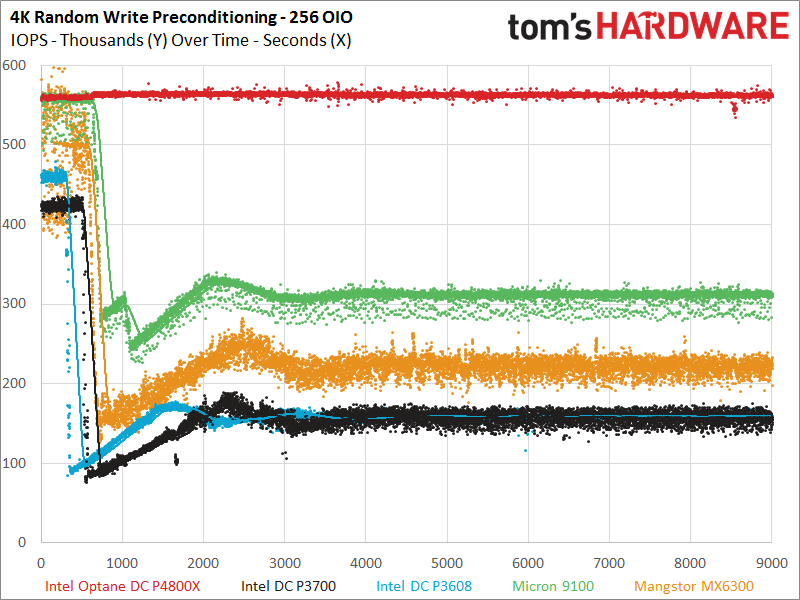
We typically present preconditioning plots for each test that are similar to these. The charts highlight the drastic performance drop with NAND-based SSDs, but those petty concerns don't apply to the DC P4800X.
Performance
As mentioned, we encountered challenges with our benchmarking software, though we've since smoothed out most of the inconsistent reporting. There are a few areas where we measured a bit of variance, such as the eight OIO (Outstanding I/O - similar to QD) results in the 4K random write test below. These might stem from excessive time calls or any number of other sources, such as drivers or the operating system. With that in mind, use the scatter charts as a guide. We also have numerous other useful measures of performance consistency in our results.
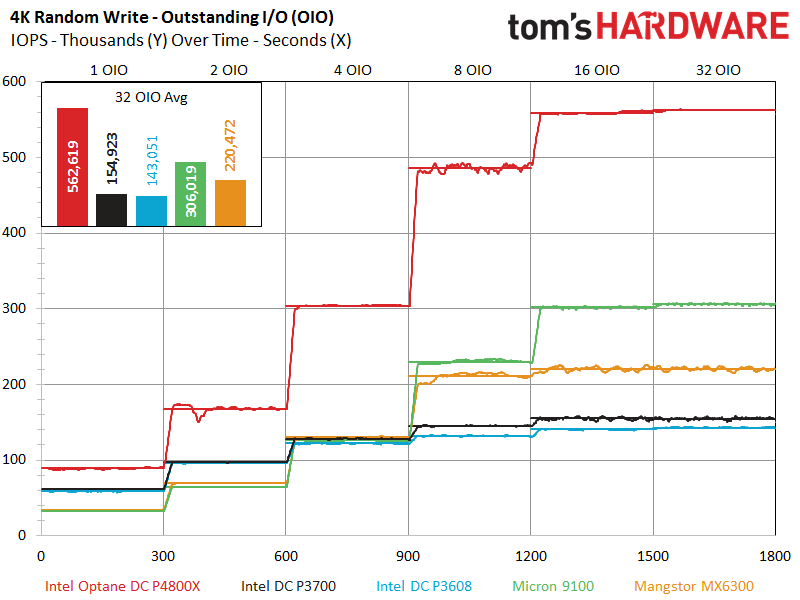




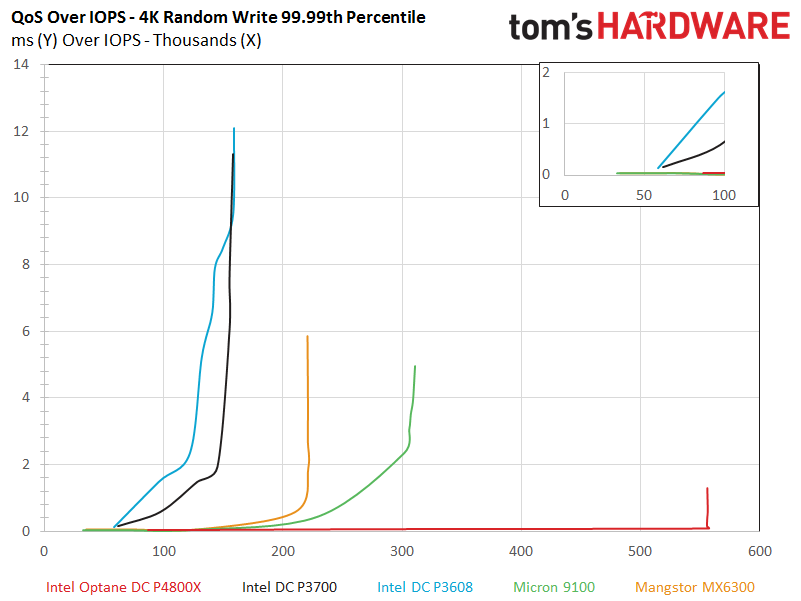



The DC P4800X jumps to an early lead with 98,000 IOPS at one OIO, and then scales wonderfully as we increase load, topping out at 16 OIO. Intel's drive is up against the fastest NAND-based SSDs on the planet, but we can still see a clear difference between 3D XPoint and its competition in this test.
Each 3D XPoint die has 64 separate regions that can respond to commands simultaneously, whereas NAND has a maximum of four (on shipping variants). That fact, along with many others, allows the Optane SSD to offer incredible scaling, even though it has far fewer die.
The outcome is impressive. Intel's DC P4800X provides 562,619 IOPS at 32 OIO, while the fastest SSD offers less than half of its performance. The QoS over IOPS charts reflect the 99.99th percentile disparity between the DC P4800X and normal SSDs.
Get Tom's Hardware's best news and in-depth reviews, straight to your inbox.

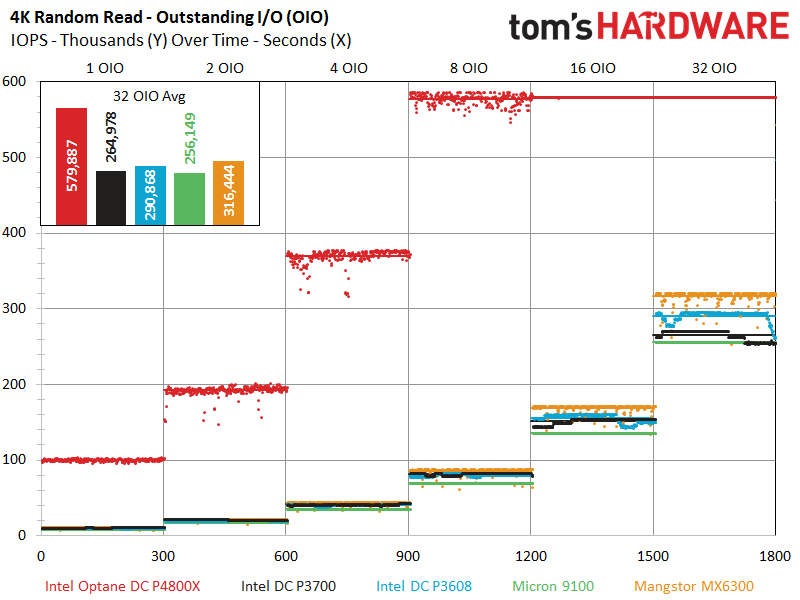






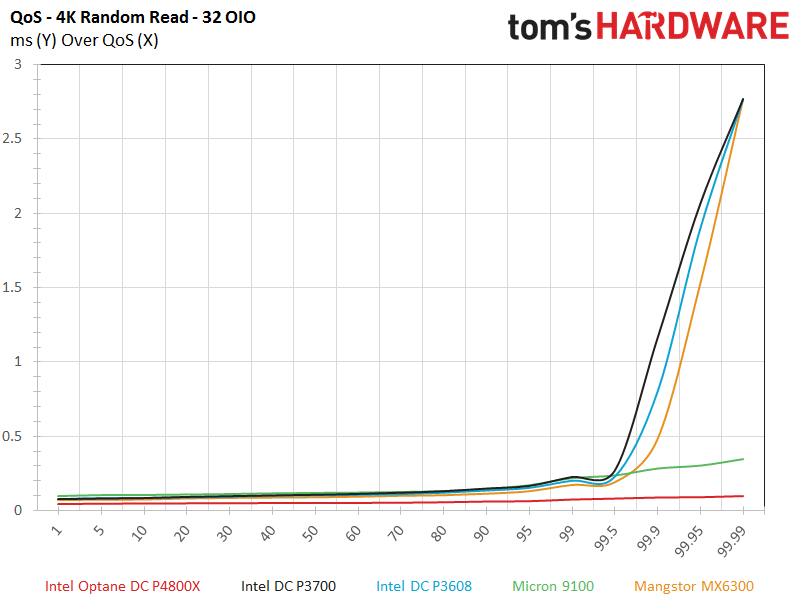
The 4K random read workloads are even more impressive. Intel's P4800X provides its maximum performance at eight OIO, whereas the regular SSDs don't hit their stride until they reach 256 OIO. The DC P4800X tops out at 580K IOPS. And while other SSDs are faster beyond 64 OIO, that doesn't mean much. They won't encounter such intense I/O in a real-world application.
For our standard line charts, we also have small embedded charts with a zoomed-in view of performance under the lightest loads during the tests. The DC P4800X provides exponentially better random read latency until it reaches its saturation point, and it follows a similar trend with 99.99th percentile and standard deviation performance.



Intel checks the boxes on industry-leading random read and write performance. But mixed random workloads are where this drive's rubber meets the road. A pure random read or write workload is exceedingly rare during normal use, so we test every 4K read/write mixture. The DC P4800X easily dispatches the competition at 256 OIO, and the picture gets even more convincing under lighter workloads, which we'll parse and add as time permits.
Most important, the QoS chart highlights another big advantage.
MORE: Best Enterprise SSDs
Current page: 4K Random Read & Write
Prev Page Latency Measurements Next Page 8K Random Read & Write
Paul Alcorn is the Editor-in-Chief for Tom's Hardware US. He also writes news and reviews on CPUs, storage, and enterprise hardware.
-
Geekwad A true signal that raw processing power is played out.Reply
Storage of all kinds and an increased focus on parallelism in software implementations is more exciting. -
anbello262 I can't wait to have the consumer version. I can cleary see in a few years ssd replacing hdd for storage, and xpoint replacing ssd for OS/boot/programs.Reply -
shrapnel_indie Call me when the testing is completed with real hardware on hand. Its too easy to simulate in a virtual environment. (Not saying they did, but the potential exists.) The numbers are nice though.Reply